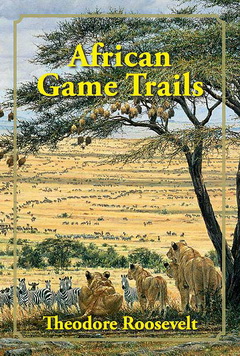| |
|
|
Книги - Африканская охота - AFRICAN GAME TRAILS
Roosevelt, Theodore An Account of the Wanderings of an American Hunter-Naturalist
| Product: |
«» |
 |

|
Price: EUR 70,-
2009 Long Beach, 582pp, profuse photos, maps, drawings by Phillip Goodwin ISBN: 1-57157-331-3 Binding: Trim Size: 6 x 9, hardcover with dustjacket |
|
|
There are safaris and then there are safaris, and it is in the latter category that the African hunt of Teddy Roosevelt and his son Kermit definitely falls. Leaving New York harbor in March 1909, the pair set forth via ship and arrived in Mombasa, Kenya Colony. After their arrival, they took the railroad to Nairobi where a virtual who’s who of Kenya came to pay their respects to the former president.
President Roosevelt’s African safari was nothing short of grandiose. There was a huge retinue of professional hunters, including stars like Frederick Selous and R. J. Cunninghame. They had a virtual army of porters who moved tons of equipment (including a library personally selected by TR) into the interior of Kenya. The ever-flamboyant TR even flew a large Stars and Stripes over the main tent. No expense was spared in this extravaganza.
Their journey proceeded largely on foot via numerous sidetracks to Lake Victoria. After crossing Lake Victoria, the party hunted in Uganda before heading north to the Lado Enclave and then on to southern Sudan. After descending the Nile River, the Roosevelts emerged in Khartoum from the darkest sections of the great African continent in March 1910.
The safari, which was undertaken for the Smithsonian Museum, took about one year, and its emphasis was on the Big Five. Kermit hunted the more difficult species such as bongo in Kenya, sitatunga in Uganda, white rhino in the Lado Enclave, and giant eland in southern Sudan. By today’s standards the amount of game shot would be considered inappropriate, but it must be remembered that in those days lions and leopards were considered vermin, no game license was needed to hunt them, and multiple elephant and rhino were issued on one hunting license.
During the course of the safari, TR sent dispatches of his hunts to Scribner’s Magazine that were read by millions of people back in the States. These stories formed the basis of his book, African Game Trails, which was originally issued in book form in 1910. This Safari Press edition celebrates the 100-year anniversary of the greatest of all African hunts by an American president considered an icon of the hunting world. Reproduced on quality paper with the photos on coated paper to allow for the best possible reproduction of the now 100-year-old images.
Cover art, “Wildebeest Migration,” ©2008 Simon Combes Estate, is courtesy of the Greenwich Workshop, Inc. |
 |
| Product: |
PreviousNext |
|
|






















